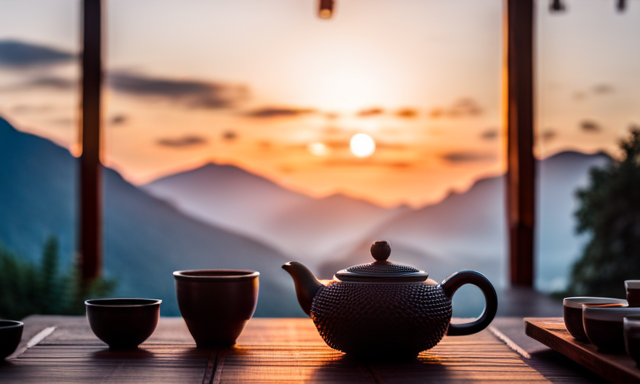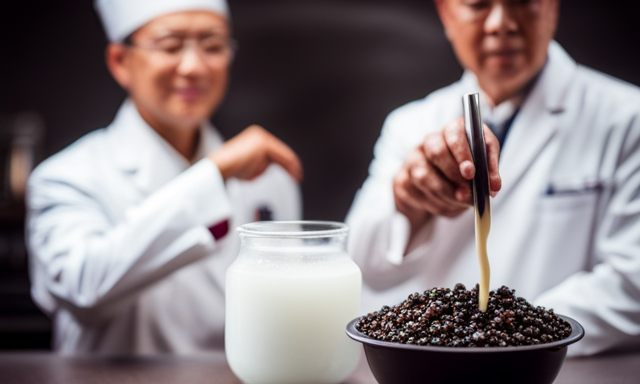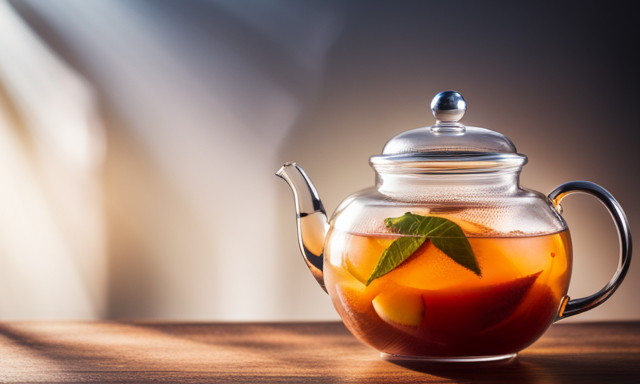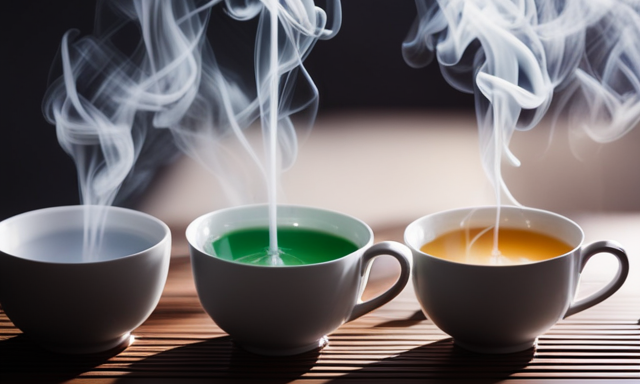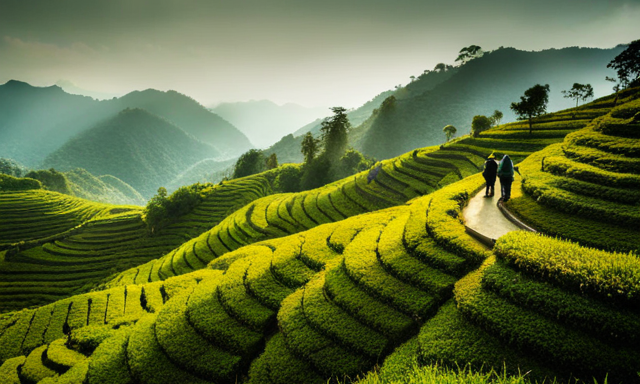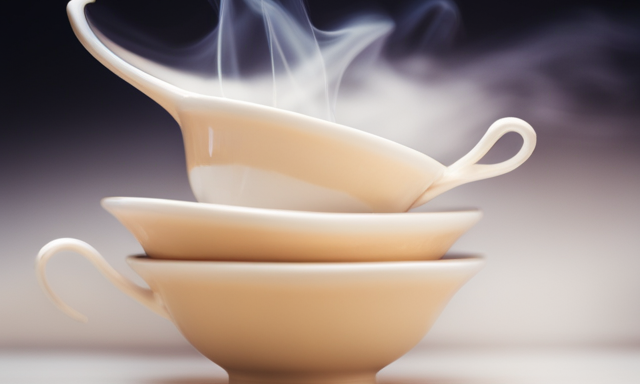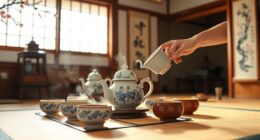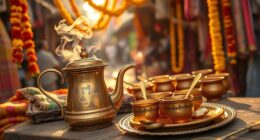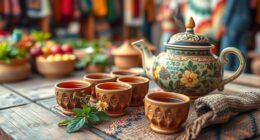Have you ever wondered just how many times you can brew oolong tea?
Well, let me take you on a journey through the fascinating world of oolong tea steeping. With its rich history and complex flavors, oolong tea is a true delight for the senses. In this article, we will explore the art of steeping oolong tea and uncover the secrets behind multiple brews.
From the first unveiling of flavors to the exploration of subtle nuances, we will delve into the full flavor profile of oolong tea. But that’s not all – we will also discuss the difference between re-steeping and oversteeping, and provide you with tips and tricks for extended brews.
So, grab your favorite oolong tea leaves and get ready to embark on a journey of taste and aroma like no other.
Key Takeaways
- Multiple infusions are possible with oolong tea.
- Re-steeping extracts flavor, while oversteeping results in bitterness.
- Re-steeping techniques like cold brew, Gong Fu Style, and Grandpa Style can be used.
- Re-steeping extends the life of oolong tea and allows for multiple brews.
Understanding Oolong Tea: A Brief Introduction
You can brew oolong tea multiple times, extracting different flavors and aromas with each steep.
Oolong tea has a brief history that dates back to ancient China, where it was first cultivated and enjoyed by emperors.
This tea is known for its unique processing method, which involves withering the leaves under the sun, oxidizing them partially, and then firing them to stop the oxidation process. This unique process gives oolong tea a distinct flavor profile that falls somewhere between green and black tea.
In addition to its delightful taste, oolong tea is also known for its numerous health benefits. It’s rich in antioxidants, helps in weight management, promotes heart health, and boosts metabolism.
Now, let’s dive into the art of steeping oolong tea and explore the various techniques to bring out the best flavors in each cup.
The Art of Steeping Oolong Tea
When it comes to steeping oolong tea, there are a few key points to consider. First, choosing the right water temperature is crucial for bringing out the best flavor and aroma.
Second, determining the ideal steeping time is important to avoid over-extraction or under-extraction.
And finally, using the correct tea-to-water ratio ensures a well-balanced and flavorful brew.
By paying attention to these factors, you can master the art of steeping oolong tea and enjoy a truly delightful cup every time.
Choosing the Right Water Temperature
To get the perfect cup of oolong tea, it’s crucial to nail the right water temperature. The water temperature selection has a significant impact on the flavor and aroma of the tea.
Oolong tea is delicate and requires a precise water temperature to bring out its unique characteristics. Generally, it’s recommended to use water that’s around 180°F (82°C) for lighter oolong teas and 190-200°F (88-93°C) for darker oolong teas. Steeping oolong tea at too high a temperature can result in a bitter taste, while steeping at too low a temperature may not fully extract the flavors.
Determining the ideal steeping time is equally important, as it allows the tea leaves to unfurl and release their flavors.
Now, let’s explore the next step in brewing the perfect cup of oolong tea: determining the ideal steeping time.
Determining the Ideal Steeping Time
Explore the perfect steeping time to unlock the full flavors of your oolong tea and captivate your taste buds. Determining the optimal brewing time is crucial to ensure that you achieve the desired taste and aroma.
The ideal steeping time for oolong tea can vary depending on the type and quality of the tea, as well as personal preference. It’s recommended to start with a shorter steeping time, around 2-3 minutes, and gradually increase it if needed. Experimenting with different steeping times allows you to find the perfect balance between flavor and strength. Be mindful not to overbrew oolong tea, as it can result in a bitter taste.
Once you’ve mastered the art of determining the ideal steeping time, you can move on to the next step of using the correct tea-to-water ratio for a truly delightful cup of oolong tea.
Using the Correct Tea-to-Water Ratio
Achieve a harmonious balance of flavors by ensuring you have the perfect tea-to-water ratio for brewing your oolong. To make the most out of your oolong tea, follow these essential steps:
-
Measure: Start by measuring the right amount of tea leaves. A general rule of thumb is to use one teaspoon of tea for every 8 ounces of water.
-
Experiment: Adjust the ratio to suit your personal taste. If you prefer a stronger flavor, increase the amount of tea leaves. For a milder taste, reduce the amount.
-
Water Temperature: Oolong tea is best brewed with water that’s around 190-205°F (88-96°C). This temperature range allows the tea to release its complex flavors without becoming bitter.
By following the correct tea-to-water ratio and steeping your oolong tea at the optimal water temperature, you can unlock its full potential. Now, let’s move on to the first brew and unveil the initial flavors.
First Brew: Unveiling the Initial Flavors
Indulge in the rich and aromatic flavors of your first brew of oolong tea – a taste that’ll transport you to a tranquil oasis. When brewing oolong tea, the initial flavors are crucial in creating a delightful experience. To bring out the best of these flavors, it’s essential to follow proper brewing techniques.
Start by steeping one teaspoon of oolong tea leaves in 8 ounces of water heated to around 190°F for about 3-4 minutes. This’ll allow the tea to release its initial flavors, which can range from floral and fruity to toasty and nutty. The precise brewing time may vary depending on personal preference and the specific oolong tea variety.
As the first brew unveils its unique characteristics, it sets the stage for further exploration into the subtle nuances that follow.
Second Brew: Exploring the Subtle Nuances
As you savor the second infusion, you’ll be captivated by the delicate layers of flavor that unfold with each sip. The aroma of the oolong tea intensifies, filling the air with a tantalizing scent that entices your senses.
The tasting notes become more pronounced, revealing subtle nuances that were hidden in the first brew. Here are four key elements to explore:
-
Floral undertones: The tea leaves release a delicate floral fragrance, reminiscent of orchids or jasmine.
-
Fruity hints: A subtle sweetness emerges, with notes of peach or apricot dancing on your palate.
-
Toasted undertones: As the leaves unfurl further, a gentle toasty flavor adds depth and complexity to the tea.
-
Lingering aftertaste: The finish is smooth and long-lasting, leaving a pleasant aftertaste that lingers on your tongue.
As you anticipate the third brew, get ready to unleash the full flavor profile of this remarkable oolong tea.
Third Brew: Unleashing the Full Flavor Profile
After exploring the subtle nuances of a second brew, it’s time to unleash the full flavor profile of oolong tea. This is where the true magic happens. By the third brew, the leaves have fully unfurled, releasing their rich aromas and complex flavors. To maximize the brews, it’s essential to understand the brewing parameters and adjust accordingly.
In a 3×3 table, the first column can be dedicated to the brewing parameter, the second to the ideal range, and the third to the adjustments needed for the third brew:
| Brewing Parameter | Ideal Range | Adjustment for Third Brew |
|---|---|---|
| Water Temperature | 195-205°F | Increase by 5-10°F |
| Steeping Time | 3-4 minutes | Increase by 1-2 minutes |
| Leaf-to-Water Ratio | 1:15 | Maintain the same ratio |
By following these guidelines, you can unleash the full potential of oolong tea and extract every last drop of goodness. But don’t stop here! The journey continues with the fourth brew and beyond, where we extract the last drops of goodness from these remarkable leaves.
Fourth Brew and Beyond: Extracting the Last Drops of Goodness
Continuing the journey, the extraction of the last remnants of exquisite flavors and aromas from these remarkable leaves is achieved through the fourth brew and beyond. To extract maximum flavor and prolong tea sessions, follow these steps:
-
Extend the steeping time: With each subsequent brew, increase the steeping time by 30 seconds to allow the leaves to fully release their flavors.
-
Adjust the water temperature: Lower the water temperature slightly to prevent over-extraction while still extracting the remaining goodness from the leaves.
-
Increase the leaf-to-water ratio: Add a few extra leaves to intensify the flavor and ensure a robust brew.
By following these techniques, you can continue to enjoy the rich taste and aroma of oolong tea, even after multiple infusions.
Now, let’s delve into the next section about ‘re-steeping vs. oversteeping: knowing the difference’ to further enhance your tea brewing skills.
Re-steeping vs. Oversteeping: Knowing the Difference
To fully savor the exquisite flavors of your brew, it’s important to distinguish between re-steeping and oversteeping, allowing you to enjoy your tea to the fullest. Re-steeping is the process of extracting additional flavor from the same tea leaves, while oversteeping occurs when the tea is brewed for too long, resulting in a bitter and unpleasant taste. By understanding the difference, you can maximize flavor extraction and make the most of your oolong tea.
Here is a helpful table to guide you through re-steeping techniques:
| Re-Steeping Technique | Instructions |
|---|---|
| Cold Brew | Steep tea leaves in cold water for an extended period to extract a delicate and refreshing flavor. |
| Gong Fu Style | Use a smaller teapot and shorter steeping times to produce multiple cups of concentrated tea. |
| Grandpa Style | Add hot water to a cup with tea leaves and let it steep. This method is simple and convenient. |
By employing these re-steeping techniques, you can extend the life of your oolong tea and continue to enjoy its rich taste. Now, let’s move on to some tips and tricks for extended brews.
Tips and Tricks for Extended Brews
Let’s dive into some handy tips and tricks to enhance your extended brewing experience! When it comes to extended brews, maximizing flavor is key.
Here are some tips to help you achieve the best results:
-
Use high-quality oolong tea leaves: The better the tea, the more flavor it’ll impart.
-
Adjust brewing time: Experiment with longer steeping times to extract more flavor from the leaves.
-
Increase water temperature: Hotter water can unlock more complex flavors in oolong tea.
-
Re-steep multiple times: Oolong tea can be brewed multiple times, so don’t waste those leaves!
-
Try cold brewing: Cold brewing oolong tea overnight can result in a refreshing and flavorful drink.
By following these tips, you can enjoy the benefits of oolong tea beyond the cup.
Enjoying the Benefits of Oolong Tea Beyond the Cup
Get ready to experience the amazing benefits of oolong tea in ways you never thought possible! Did you know that oolong tea can do wonders for your skin? It’s packed with antioxidants that can help fight free radicals and reduce signs of aging. Incorporating oolong tea into your skincare routine can leave your skin looking radiant and youthful.
You can try using it as a toner or even create homemade face masks with oolong tea for a natural glow.
But the benefits of oolong tea don’t stop there! You can also incorporate it into your favorite recipes for a unique and delicious twist. Oolong tea can be used as a marinade for meats, added to baked goods for a subtle flavor, or even used to make refreshing iced tea desserts. The possibilities are endless!
So, next time you brew a cup of oolong tea, remember that its benefits extend beyond just a beverage. Embrace the versatility of oolong tea and explore new ways to enjoy its many benefits for your skin and in your kitchen.
Frequently Asked Questions
How long should I steep oolong tea for each brew?
For the optimal steeping time and best brewing techniques, I suggest steeping oolong tea for 3-5 minutes. This allows the flavors to fully develop, like a delicate dance between the leaves and hot water.
Can I reuse the oolong tea leaves for more than four brews?
Yes, you can reuse oolong tea leaves for more than four brews. Oolong is known for its ability to be steeped multiple times while still maintaining its rich flavor and aroma.
What is the difference between re-steeping and oversteeping oolong tea?
Oversteeping oolong tea is like leaving a teabag in hot water for too long – it can make the tea bitter and unpleasant. On the other hand, re-steeping oolong tea allows you to enjoy its full flavor and reap the benefits of multiple brews.
Are there any health benefits to drinking oolong tea?
Drinking oolong tea can have health benefits such as aiding in weight loss and promoting mental well-being. It is known to boost metabolism and reduce stress levels, making it a beneficial addition to a healthy lifestyle.
Can I add any sweeteners or milk to oolong tea?
Yes, you can add sweeteners to oolong tea to enhance its flavor. However, adding milk is not recommended as it may overpower the delicate taste. Experiment with different sweeteners to find your perfect blend.
Conclusion
So there you have it, tea enthusiasts! After delving into the world of oolong tea and mastering the art of steeping, we can confidently say that the possibilities are endless.
With each brew, we unlock new layers of flavor and experience the true essence of this exquisite tea. Whether it’s your first brew or your tenth, the journey of oolong tea is one that never disappoints.
So go ahead, indulge in the last drops of goodness and savor the euphoric journey that oolong tea takes you on. Cheers to a world of endless brewing possibilities!

